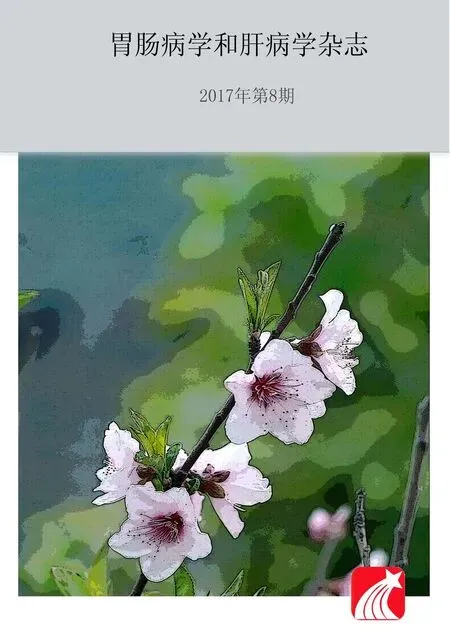胃黏膜病理与幽门螺杆菌和胃蛋白酶原的相关性分析
2017-09-12付明生蔡勋全潘勤聪
徐 林,付明生,蔡勋全,潘勤聪
复旦大学附属上海市第五人民医院消化内科,上海200240
胃黏膜病理与幽门螺杆菌和胃蛋白酶原的相关性分析
徐 林,付明生,蔡勋全,潘勤聪
复旦大学附属上海市第五人民医院消化内科,上海200240
目的 探讨不同胃黏膜病理表现与幽门螺杆菌(Helicobacter pylori,H.pylori)、血清胃蛋白酶原的相关性。方法 收集复旦大学附属上海市第五人民医院2015年7月-2016年6月完成胃镜活检病理、H.pylori测定及胃蛋白酶原(pepsinogen,PG)检测的患者386例,并分析其相关性。结果 胃黏膜病理与H.pylori感染无显著相关性(R=-0.084,P=0.100);胃黏膜病理与胃蛋白酶原Ⅰ(PGⅠ)无显著相关性(R=-0.003,P=0.949),与PGⅡ呈正相关(R=0.258,P=0.000),与胃蛋白酶原比值(PGR)呈负相关(R=-0.194,P=0.000);H.pylori与 PGⅠ无显著相关性(R=-0.033,P=0.522),与 PGⅡ呈负相关(R=-0.173,P=0.001),与PGR无显著相关性(R=0.093,P=0.069)。胃黏膜病理与癌胚抗原(CEA)呈正相关(R=0.146,P=0.004),与年龄无显著相关性(R=-0.004,P=0.930)。结论 胃黏膜病理改变与H.pylori感染无显著相关性,与PGⅡ及CEA呈正相关,与PGR呈负相关,H.pylori与PGⅡ呈负相关,与PGR无相关性。
幽门螺杆菌;胃蛋白酶原;胃黏膜病理
幽门螺杆菌(Helicobacter pylori,H.pylori)是胃黏膜病变的重要致病因素,与慢性胃炎、萎缩性胃炎、胃溃疡密切相关,而且与消化不良、胃黏膜相关性淋巴组织(MALT)淋巴瘤和胃癌也有重要关系,已被WHO列为胃癌等恶性肿瘤发生的相关致病菌[1-2]。胃蛋白酶原(pepsinogen,PG)是胃蛋白酶的前体,是胃黏膜的分泌产物,有PGⅠ和PGⅡ两种同工酶原。血清PG可反映胃黏膜状态和功能。H.pylori感染可能引起胃黏膜病理改变、血清PG改变,本文就胃黏膜病理与H.pylori、血清PG的相关性进行探讨。
1 资料与方法
1.1 一般资料 收集复旦大学附属上海市第五人民医院2015年7月-2016年6月完成胃镜活检病理、H.pylori病理测定及血清PG检测的患者共386例,其中慢性非萎缩性胃炎147例,慢性非萎缩性胃炎伴肠化78例,慢性萎缩性胃炎43例,慢性萎缩性胃炎伴肠化71例,低级别上皮内瘤变9例,高级别上皮内瘤变6例,胃癌32例(见表1)。
1.2方法患者晨起空腹采静脉血,以酶联免疫吸附测定(ELISA)定量检测血清PGⅠ、PGⅡ,按PGⅠ、PGⅡELISA试剂盒(北京美康生物技术研究中心)说明书操作,通过TIANSHI SM-3酶标仪读取PGⅠ、PGⅡ值,计算胃蛋白酶原比值(PGR),通过罗氏电化学发光仪(Roche Cobas E601)用电化学发光免疫分析法(ECLIA)检测癌胚抗原(CEA)。
1.3 统计学处理 采用SPSS 19.0进行统计分析,计量资料用±s表示,使用 t检验;计数资料用例数(%)表示,使用χ2检验,相关性分析采用 Pearson检验,P<0.05为差异有统计学意义。
2 结果
2.1 H.pylori与胃黏膜病理的相关性 386例患者中,253例H.pylori阳性,感染率为65.54%。胃黏膜病理与H.pylori感染无显著相关性(R=-0.084,P=0.100,见表2)。

表1 胃黏膜病理与性别、年龄分布关系Tab 1 The relationship of gastric mucosal pathology with gender and age distribution

表2 胃黏膜病变与H.pylori感染的关系[例数(%)]Tab 2 The relationship between gastric mucosal lesions and H.pylori infection[n(%)]
2.2 血清PG与胃黏膜病理的相关性 胃黏膜病理与PGⅠ无显著相关性(R=-0.003,P=0.949),与 PGⅡ呈正相关(R=0.258,P=0.000),与 PGR 呈负相关(R=-0.194,P=0.000)(见表3、图1)。
表3 胃黏膜病理与PG及CEA关系(±s)Tab 3 The relationship of gastric mucosal pathology with PG and CEA(±s)

表3 胃黏膜病理与PG及CEA关系(±s)Tab 3 The relationship of gastric mucosal pathology with PG and CEA(±s)
组别 例数 CEA(ng/ml) PGⅠ(μg/L) PGⅡ(μg/L)PGR慢性非萎缩性胃炎 147 2.56±2.03 135.56±53.14 16.07±11.64 13.98±15.81慢性非萎缩性胃炎伴肠化 78 2.91±3.37 143.01±56.20 12.99±9.11 15.59±11.06慢性萎缩性胃炎 43 2.46±1.31 120.53±58.25 35.56±14.31 3.51±1.34慢性萎缩性胃炎伴肠化 71 4.45±19.85 120.99±56.40 34.84±21.16 4.05±1.63低级别上皮内瘤变 9 9.64±19.50 75.11±53.26 41.84±17.80 1.93±1.31高级别上皮内瘤变 6 2.12±0.95 169.62±70.89 56.32±24.77 3.51±1.70胃癌 32 46.47±155.69 147.27±55.44 27.97±27.51 11.02±10.29 F 值 4.48 3.82 28.04 12.53 P值0.000 0.001 0.000 0.000

图1 各组胃黏膜病理与PGR比较Fig 1 Comparison of gastric mucosal pathology and PGR in each group
2.3 H.pylori与血清 PG 的相关性 H.pylori与 PGⅠ无显著相关性(R=-0.033,P=0.522),与 PGⅡ呈负相关(R=-0.173,P=0.001),与 PGR 无显著相关性(R=0.093,P=0.069)。
2.4 胃黏膜病理与CEA、年龄的相关性 胃黏膜病理与 CEA 呈正相关(R=0.146,P=0.004),与年龄变化无显著相关性(R=-0.004,P=0.930)。
3 讨论
H.pylori是常见的致病菌。H.pylori在发达国家感染率为30%~50%,在发展中国家为80%~90%,是上消化道疾病的主要病因[3]。H.pylori感染不但与消化性溃疡和慢性胃炎的发生有密切关系,而且与非溃疡性消化不良、胃黏膜相关性淋巴组织(MALT)淋巴瘤和胃癌也有重要关系,已被WHO列为胃癌等恶性肿瘤发生的相关致病菌。H.pylori感染已明确与细胞增生和凋亡有关,表明其在上皮细胞恶性转化中起重要作用[4]。研究[5]认为,在 H.pylori持续感染作用下,胃黏膜炎症得以持续发展,诱导原癌基因和抑癌基因突变与激活,引起细胞增殖与凋亡之间的平衡紊乱,促进细胞恶变。本研究发现,胃黏膜病理从慢性非萎缩性胃炎、慢性非萎缩性胃炎伴肠化、慢性萎缩性胃炎、慢性萎缩性胃炎伴肠化、低级别上皮内瘤变、高级别上皮内瘤变到胃癌变化过程中,H.pylori感染率并无显著性增加,无明显相关性,胃癌组与慢性非萎缩性胃炎伴肠化组H.pylori感染率比较,差异有统计学意义,与其余各组比较,差异均无统计学意义,可能与研究样本量小有关,还需扩大样本量观察。
PG属门冬氨酸蛋白酶家族,是胃黏膜特异性功能酶,是胃蛋白酶的前体,是胃黏膜的分泌产物,按其生化性质和免疫原性可分为PGⅠ和PGⅡ两个亚群。PGⅠ主要由胃底腺的主细胞和黏液颈细胞分泌。而PGⅡ除由上述两种细胞分泌外,还可由幽门腺、贲门腺和十二指肠上段的Brunner腺分泌。正常情况下,胃黏膜产生的PG大部分进入胃腔转变为胃蛋白酶,约1%PG透过胃黏膜毛细血管进入血循环,最后以非活性形式经尿排泄。PG在血液中非常稳定,PGⅠ和PGⅡ反映胃黏膜腺体和细胞的数量,也间接反映胃黏膜不同部位的状态和分泌功能,胃黏膜发生病变时,PG分泌细胞受累,血清PG水平也发生相应变化,故有人称血清PG检测为胃底腺黏膜血清学活检,胃黏膜的病变可引起PG代谢异常,血清PGⅠ、PGⅡ水平也发生相应的变化[6]。本研究发现,胃黏膜病理与PGⅠ无显著相关性,与PGⅡ及PGR均有显著相关性,推测PGⅡ、PGR更能反映胃黏膜病理改变,对胃黏膜病变的诊断更有价值。我们的前期研究[7]发现,PGR=2.78时诊断胃癌敏感性为72.7%,特异性为77.2%,以PGR=2.78为界值诊断胃癌的阳性率为61.5%(56/91),漏诊率为38.5%(35/91)。
CEA是人类胚胎抗原特异性决定簇的酸性糖蛋白,在正常成年人循环血液中含量极微,其升高程度与癌细胞增殖数量密切相关,是消化道肿瘤常用的检测指标之一,是胃癌及癌前病变、治疗后监视复发的敏感指标,对胃癌的早期诊断、治疗及评估预后有重要价值[8]。本研究发现,胃黏膜病理与CEA有显著相关性,胃癌组CEA显著升高。胃黏膜病理与年龄变化无显著相关性,考虑与患者年龄大(各组患者平均年龄在60岁以上)有关,不能反映年龄变化趋势,是研究胃黏膜病理与年龄变化相关性的不足。
综上所述,胃黏膜病理改变与H.pylori感染无显著相关性,与PGⅡ及CEA呈正相关,与PGR呈负相关,H.pylori与PGⅡ呈负相关,与PGR无相关性,CEA显著升高要考虑到胃癌的可能。
[1]Blaser MJ,Atherton JC.Helicobacter pylori persistence:biology and disease[J].J Clin Invest,2004,113(3):321-333.
[2]Malfertheiner P,Megraud F,O’Morain C,et al.Current concepts in the management of Helicobacter pylori infection:the MaastrichtⅢConsensus Report[J].Gut,2007,56(6):772-781.
[3]Goodman KJ,Cockburn M.The role of epidemiology in understanding the health effects of Helicobacter pylori[J].Epidemiology,2001,12(2):266-271.
[4]Yan J,Zhang M,Zhang J,et al.Helicobacter pylori infection promotes methylation of WWOX gene in human gastric cancer[J].Biochem Biophys Res Commun,2011,408(1):99-102.
[5]Peek RM Jr,Crabtree JE.Helicobacter infection and gastric neoplasia[J].J Pathol,2006,208(2):233-248.
[6]Miki K.Gastric cancer screening by combined assay for serum anti-Helicobacter pylori IgG antibody and serum pepsinogen levels-“ABC method”[J].Proc Jpn Acad Ser B Phys Biol Sci,2011,87(7):405-414.
[7]付明生,潘淑贤,朱金水.血清胃蛋白酶原比值和CA724对胃癌的诊断价值及相关性分析[J].胃肠病学和肝病学杂志,2014,23(3):256-258.
Fu MS,Pan SX,Zhu JS.Correlation between serum pepsinogen ratio and carbohydrate antigen 724 and the value of them in diagnosis of gastric cancer [J].Chin J Gastroenterol Hepatol,2014,23(3):256-258.
[8]Ishigami S,Natsugoe S,Hokita S,et al.Clinical importance of preoperative carcinoembryonic antigen and carbohydrate antigen 19-9 levels in gastric cancer[J].J Clin Gastroenterol,2001,32(1):41-44.
(责任编辑:李 健)
勘误:我刊2017年第26卷第7期第736页,第一作者关宇昕的文章《化学缺氧对小鼠胰腺星状细胞增殖活化的影响》,通讯作者崔培林的单位更改为“首都医科大学附属北京天坛医院”。
Correlation of gastric mucosal pathology with Helicobacter pylori and pepsinogen
XU Lin,FU Mingsheng,CAI Xunquan,PAN Qincong
Department of Gastroenterology,the Fifth People’s Hospital of Shanghai,Fudan University,Shanghai 200240,China
ObjectiveTo investigate the correlation of different gastric mucosal pathologic manifestations with Helicobacter pylori(H.pylori)and serum pepsinogen.MethodsThree hundred and eighty-six patients who completed the endoscopy biopsy pathology,H.pylori pathology determination and pepsinogen(PG)detection were collected in the Fifth People’s Hospital of Shanghai,Fudan University from Jul.2015 to Jun.2016,and the correlation was analyzed.ResultsGastric mucosal pathology was not associated with H.pylori infection(R=-0.084,P=0.100).Gastric mucosal pathology was not significantly correlated with pepsinogenⅠ (PGⅠ)(R=-0.003,P=0.949),but was positively correlated with PGⅡ (R=0.258,P=0.000)and negatively correlated with pepsinogen ratio(PGR)(R=-0.194,P=0.000).There was no significant correlation between H.pylori and PGⅠ (R=-0.033,P=0.522),but H.pylori was negatively correlated with PGⅡ (R=-0.173,P=0.001).Gastric mucosal pathology was positively correlated with CEA(R=0.146,P=0.004),but not correlated with age(R=-0.004,P=0.930).ConclusionGastric mucosal pathological changes is not correlated with H.pylori infection,and positively correlated with PGⅡ and CEA,and negatively correlated with PGR,H.pylori is negatively correlated with PGⅡ,and not correlated with PGR.
Helicobacter pylori;Pepsinogen;Gastric mucosal pathology
R573;R378
A
1006-5709(2017)08-0918-03
2016-11-30
10.3969/j.issn.1006-5709.2017.08.021
付明生,硕士,副主任医师。E-mail:fumingsheng3428@126.com
